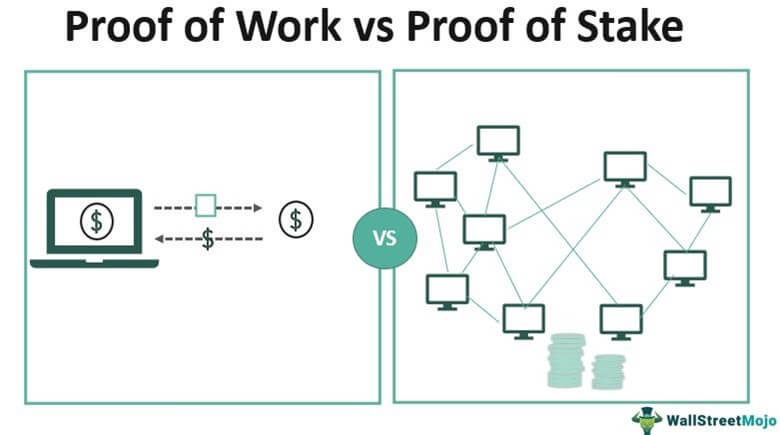
The Proof of Stake algorithm was created as an alternative to the Proof of Work used for cryptocurrency verification. The principle of operation of PoS is similar to smart contacts, it is used to protect the data of digital currency owners.
What is Proof of Stake
First of all, you should understand proof of stake – what is it? PoS technology is based on consensus protocols that govern the cryptocurrency system. It is one of the protection methods, in which “shares” are taken as a basis as a resource that establishes which particular node has the right to mine the next block. This is an alternative to the current PoW. However, the algorithm does not require a lot of energy to provide workflows. In addition, there is no need for computer algorithms. PoS is based on data on the number of coins a miner has. This gives more independence to PoS tokens.
The right to generate a block goes to the node with the largest balance. This is a fairly attractive scheme that does not have requirements for computing resources, so there is no question of using them for nothing.
Types of PoS
There are several varieties of PoS. One of the most popular is DPoS. The principle is the ability to delegate coins between participants, while counting on a part of the profit, to masternodes, receiving a share of the profit of the validators.
Other types of PoS include the following:
- LPoS. Provides the ability to lend your own tokens. The transferred coins increase the value of the node, providing more chances to create a block and increase income. In exchange for tokens, the income received is provided.
- dbft. The principle is that the owners of the coins define “bookkeepers” who specialize in creating blocks and reaching consensus.
- Casper. An algorithm based on Ethereum, the goal is to switch the network from PoW to PoS with modifications. For example, with the support of an empty fork chain of the blockchain, the validator is responsible not only for the perfect bet, but also for the amount equal to the double spend of the transaction.
- PoSV. The original mining algorithm founded by Reddcoin. Developed on the proof of home, but with a modification of the original PoS algorithm for more active participation in the network. With this consensus mechanism, the income of the validator depends on the percentage of ownership of coins, as well as on the speed of work. The goal is to encourage token holders to actively participate in the sale of coins and be online.
There are other types of PoS. Before using them, it is important to understand exactly what proof of stake is, its goals and objectives.
Differences between Proof of Stake and Proof of Work
To understand what proof of stake is, you also need to understand the differences to PoW. Among them are the following:
- All operations and mining in Proof of Stake (PoS) directly depend on the number of coins in the account. The more wallets, the wider the possibilities.
- PoW requires a large energy resource to mine digital currency. PoS is in high demand by offloading the miner’s network. In 2022, the largest altcoin, Ethereum, is expected to switch to PoS. Also, the system does not require the purchase of expensive equipment with certain technical characteristics. When using PoS, the capabilities of the miner depend on the number of mined or purchased coins.
- PoS provides fast transaction processing.
- All PoS cryptocurrencies use blockchain – a system with a consensus protocol. This means that there is a certain set of rules that encourage and protect the operation of the blockchain system.
Such significant differences contribute to the active transition of users to the PoS system.
How mining works
Proof of Stake is different from the classical representation of mining. The system operates on staking. This means that performance depends on the users who store coins on the network. The principle of operation is as follows:
- The validator is the owner of the digital currency. Provides the network with available coins as collateral. This is required to participate in the validation process.
- There is no need to mine new blocks. It is enough to create and check the existing blocks of other participants.
- After each transaction, the wallet owner receives interest. If any fraudulent transactions are detected, a part of the deposit provided will be forfeited.
Income for users is provided by the amount of coins provided: the more of them, the higher the profit. To start staking, you need to choose a currency that supports PoS.
What are PoS cryptocurrencies
Today, a huge number of coins supporting PoS are provided. The most famous include the following:
- Solana is considered one of the most capitalized coins. It has a unique algorithm that helps keep track of all participants in the blockchain. Included in the top in terms of capitalization. The token trade is about $215;
- Cardano is the largest platform focused on creating smart channels, etc. The capitalization of the digital coin amounted to over $53.4 billion;
- Polkadot is a large crypto platform. It ranks ninth in terms of digital currency capitalization.
Today, it is planned to switch the Ethereum blockchain to PoS. This plan has been in development for a very long time. Its goal is to improve network scaling. However, the implementation of PoS brings with it many technical complexities compared to PoW, which is delaying the transition process, which is expected in mid-2022. Perhaps this event contributes to lower prices for video cards.
Points for and against”
Many experts highlight the following advantages in favor of PoS:
- An attack is possible when a large number of funds are attracted, which is not financially feasible. However, if the attacker has a certain number of tokens, then there is a high risk of being harmed by his own attack, as this leads to the instability of the cryptocurrency.
The use of PoS cryptocurrencies raises the following concerns:
- The system gives a powerful motivational impetus for the accumulation of funds in one hand;
- If one of the groups raises a large number of funds, it will be able to manage other groups by imposing their own working conditions.
Despite its shortcomings, Proof of Stake is a great alternative to Proof of Work. Provides simple mining and solves the problem of energy efficiency. Therefore, PoS updates should be expected. However, this would require an Ethereum transition.



Average Rating